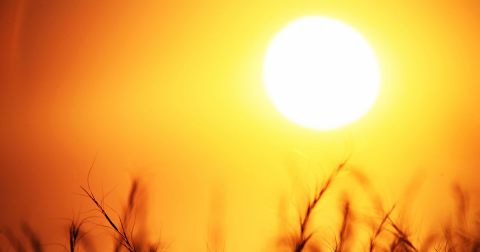 We used to think that once you got a tan, you were protected from the effects of the sun. Today we know otherwise; a tan represents the skin’s reaction to damage from ultraviolet radiation. We know the sun’s rays can damage our health in different ways.
We used to think that once you got a tan, you were protected from the effects of the sun. Today we know otherwise; a tan represents the skin’s reaction to damage from ultraviolet radiation. We know the sun’s rays can damage our health in different ways.
As a result, outdoor workers are expressing concerns about the sun as an occupational hazard. The concerns focus around a growing list of health problems linked to overexposure to sunlight. Although it is a concern for everyone, CUPE members who must work outdoors are at particular risk from the effects of ultraviolet radiation or UVR.
What is UVR?
The sun gives off a spectrum energy in the form of radiation of different wavelengths. The spectrum includes visible light and rays that generate heat. Ultraviolet (UV) refers to the types of rays that are invisible and harmful to humans. The sun’s UV includes different types of wavelengths. There are two that we need to be concerned about: ultraviolet A (UVA) and ultraviolet B (UVB). The longest wavelengths are in the UVA band, which is not screened out by the earth’s ozone layer or by glass. UVA increases acute or short-term skin damage and acts to increase the risk of skin cancer from ultraviolet B. The other band is called ultraviolet B (UVB), which is mostly responsible for sunburns and for producing cancers. UVB is partially blocked by the ozone layer, and glass will generally block it. Workers can also be exposed to ultraviolet radiation from artificial sources such as sunlamps, welding and bactericidal lamps. However, sunlight is by far the most important source of exposure
Effects of exposure
Skin cancers
There is clear medical evidence that overexposure to UVR is related to several types of skin cancers. They can usually be classified as melanomas and non-melanomas. Non-melanomas are the most common type of skin cancer. The non-melanoma tumours tend to appear on parts of the body that are usually exposed to sunlight - the neck, the face, ears, the back of hands and top of forearms. These cancers don’t usually spread, can be surgically removed and are rarely lethal.</p><p>Melanoma is a relatively rare form of skin cancer. However, they are a much greater concern because of the ability of these cancers to metastasize, or invade other parts of the body easily and to kill. In contrast to the other types of skin cancer, melanomas do not usually appear on exposed parts of the body. Finally, there is evidence that suggests some individuals are more likely to develop sun-induced skin cancers of all types. People with fair complexion, light eye and hair colour and the tendency to sunburn rather than tan are more liable to develop skin cancers.
Effects on the immune system
Ultraviolet light can have adverse effects on the immune system by affecting the skin. The skin is our first line of defence against the assault of invading organisms to which our skin is constantly exposed. It has a network of cells and proteins that play a major role in fighting off microorganisms. UVR is responsible for suppressing the immune system, leaving the body less capable of fighting off infections.
Reducing UV exposure at work
Avoid the mid-day sun
Generally, this precaution applies to summer days between 10:00 a.m. and 3:00 p.m. The amount of UV radiation that reaches us is dependant on the time of day and therefore, the angle of the sun. When the sun is near the horizon, the sun’s rays must travel a long path through the ozone, so less UVB penetrates the atmosphere. By contrast, when the sun is overhead, the sun’s rays travel a short path through the atmosphere. Scheduling work to avoid the noonday sun during summer days with high UVR readings is the best way to prevent skin cancer and other health effects from UVR. Clearly this is not an option for all workplaces, it is a suggestion for a starting point towards prevention. If re-scheduling work is not possible, the following other precautions should be followed:
Work in the shade
Create artificial shade by using sunscreens, tents or parasols. Where possible, make sure your employer makes structural changes such as building canopies or planting shade trees.
Remember that because you are working in the shade, does not mean that you are not exposed to UVR. Large amounts of UVR can still penetrate clouds and scatter once it reaches the ground. Up to 90 % of the UVR can be reflected by sand, water, concrete or snow. As a result, even shaded areas will only provide partial UVR protection. Additional precautions should be taken:
Wear protective clothing
Wide brim hats and clothing made of tightly woven fabric are some of the best protection from the effects of the sun. Tightly woven cloth filters out UVR more effectively than cloth that is loosely woven. The weave of the fabric should allow perspiration to evaporate easily. Colour is also important. A darker colour will absorb more radiation than light colour, but it will also absorb more heat. Eyes should be protected by special purpose sunglasses that will filter out both UVA and UVB rays. Not all sunglasses will offer protection from the harmful effects of both UVA and UVB, so it’s important to check with the manufacturer. Remember that UVA will pass through glass. If you are wearing dark sunglasses they may provide comfort and protection from UVB, but they could allow the eye’s pupils to dilate or enlarge allowing UVA rays to penetrate and damage the eyes.
Sunscreens
When it is not possible to control the amount of exposure by avoiding the mid-day sun, in addition to the protective clothing, workers should apply a sunscreen lotion. There are two types of lotions that can be applied - sunblocks and sunscreens. Sunblock creams such as zinc oxide or titanium dioxide create a barrier which reflects UVR. Sunscreens absorb UVR and prevent penetration to the skin.
You should apply a broad spectrum sunscreen - one that offers both UVA and UVB protection. The Canadian Cancer Society recommends a product with sun protection factor (SPF) of at least 15 to protect against sunburns and skin cancer. The SPF number is a measure of the relative length of time a person can be exposed to UVR before burning. For instance, an SPF of 15 means that you can stay out 15 times longer before you burn. Apply the sunscreen 15 to 30 minutes before going in the sun. Spread the sunscreen over all exposed parts of the body, paying particular attention to the nose, ears, neck, lips and any bald spots. Even though “waterproof” sunscreens allow up to 80 minutes between re-application, The Canadian Cancer Society recommends that you re-apply the sunscreen after perspiring heavily or if you get wet. Under no circumstances should the use of sunscreen be a reason to spend more time working outdoors. In fact, there is growing concern that the use of sunscreens may promote skin cancer by allowing us to spend more time in the sun.
The joint health and safety committee should be involved in the selection of protection and sunscreen that will be used. More employers are beginning to supply sunscreen to workers, so make sure the cost of the sunscreen is picked up by the employer.
Conclusion
The sun plays a crucial role in maintaining life on earth, but overexposure to the sun’s rays is harmful to outdoor workers. Exposure to ultraviolet radiation from the sun results in a growing list of health problems including cancer, immune system suppression, eye damage and premature aging of the skin. Skin cancer rates have risen steadily over the past 20 years. This year, it is expected that 50,000 Canadians will develop skin cancer. An estimated 3000 new cases of melanomas will be diagnosed and about 500 will die from the disease. The long-term effects of exposure to UVR can take anywhere from 10 to 20 years to show up, so most of the expected cases are the result of exposures that happened a decade or two ago. Therefore, today’s prevention becomes the key to avoiding future skin cancer from the sun.
For more information contact:
CUPE National Health and Safety Branch
1375 St-Laurent Boulevard
OTTAWA, ON K1G OZ7
Tel: (613) 237-1590
Fax: (613) 237-5508
Email: health_safety@cupe.ca



